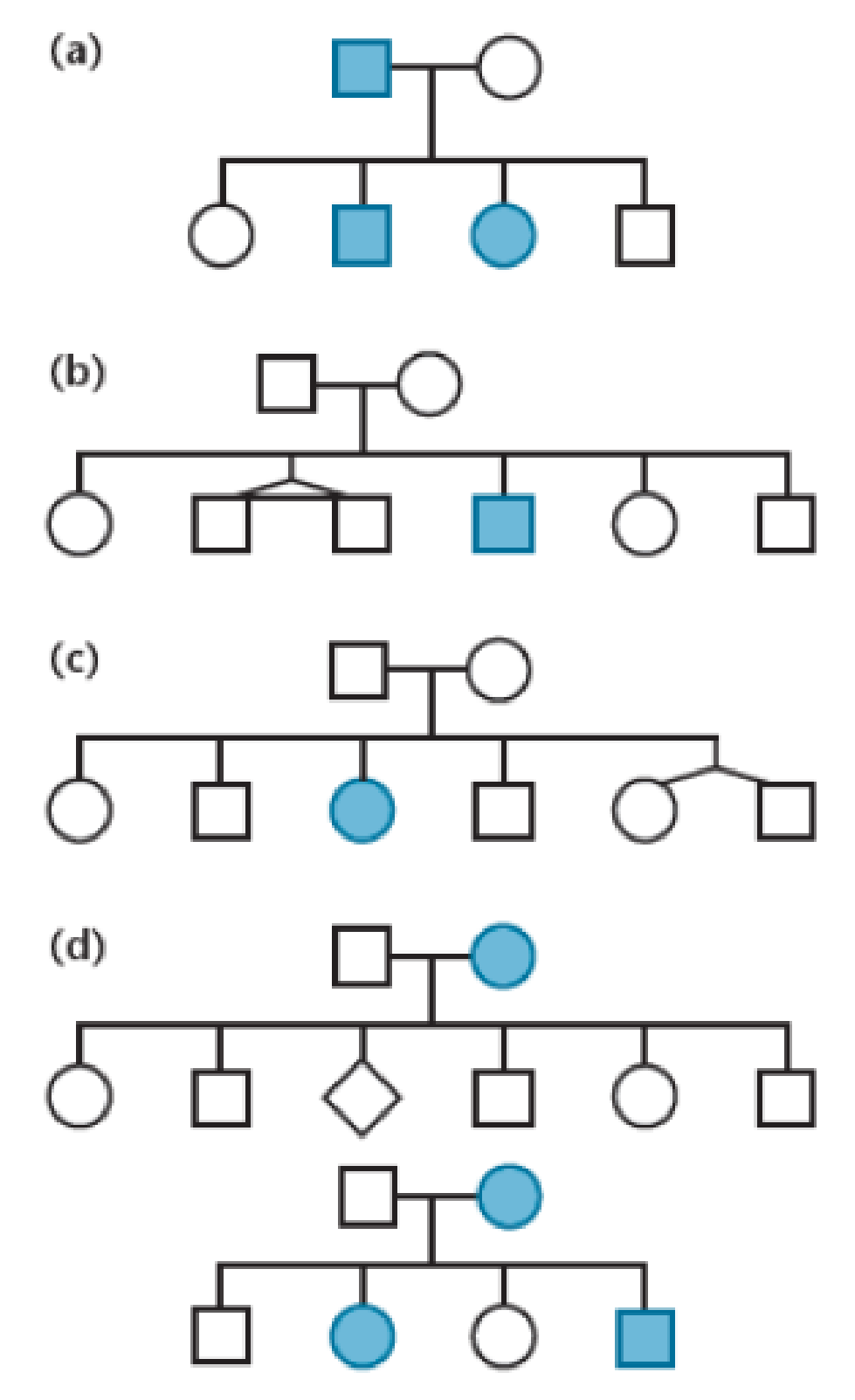
Concepts of Genetics (11th Edition)
11th Edition
ISBN: 9780321948915
Author: William S. Klug, Michael R. Cummings, Charlotte A. Spencer, Michael A. Palladino
Publisher: PEARSON
expand_more
expand_more
format_list_bulleted
Concept explainers
Textbook Question
Chapter 3, Problem 22PDQ
Draw all possible conclusions concerning the mode of inheritance of the trait portrayed in each of the following limited pedigrees. (Each of the four cases is based on a different trait.)

Expert Solution & Answer
Want to see the full answer?
Check out a sample textbook solution
Students have asked these similar questions
Explain in a small summary how:
What genetic information can be obtained from a Punnet square? What genetic information cannot be determined from a Punnet square?
Why might a Punnet Square be beneficial to understanding genetics/inheritance?
In a small summary write down:
Not part of a graded assignment, from a past midterm
Chapter 3 Solutions
Concepts of Genetics (11th Edition)
Ch. 3 - Pigeons may exhibit a checkered or plain color...Ch. 3 - Considering the Mendelian traits round versus...Ch. 3 - Using the forked-line, or branch diagram, method,...Ch. 3 - In one of Mendels dihybrid crosses, he observed...Ch. 3 - The following pedigree is for myopia...Ch. 3 - Prob. 1CSCh. 3 - Thomas first discovered a potentially devastating...Ch. 3 - Prob. 3CSCh. 3 - Prob. 4CSCh. 3 - HOW DO WE KNOW? In this chapter, we focused on the...
Ch. 3 - CONCEPT QUESTION Review the Chapter Concepts list...Ch. 3 - Albinism in humans is inherited as a simple...Ch. 3 - Which of Mendels postulates are illustrated by the...Ch. 3 - Discuss how Mendels monohybrid results served as...Ch. 3 - What advantages were provided by Mendels choice of...Ch. 3 - Mendel crossed peas having round seeds and yellow...Ch. 3 - Based on the preceding cross, what is the...Ch. 3 - Which of Mendels postulates can only be...Ch. 3 - In a cross between a black and a white guinea pig,...Ch. 3 - What is the basis for homology among chromosomes?Ch. 3 - In Drosophila, gray body color is dominant to...Ch. 3 - How many different types of gametes can be formed...Ch. 3 - Mendel crossed peas having green seeds with peas...Ch. 3 - In a study of black guinea pigs and white guinea...Ch. 3 - Mendel crossed peas having round green seeds with...Ch. 3 - Prob. 17PDQCh. 3 - The following are F2 results of two of Mendels...Ch. 3 - In assessing data that fell into two phenotypic...Ch. 3 - Prob. 20PDQCh. 3 - Consider the following pedigree. Predict the mode...Ch. 3 - Draw all possible conclusions concerning the mode...Ch. 3 - Prob. 23PDQCh. 3 - Prob. 24PDQCh. 3 - For decades scientists have been perplexed by...Ch. 3 - A wrongful birth case was recently brought before...Ch. 3 - TaySachs disease (TSD) is an inborn error of...Ch. 3 - Datura stramonium (the Jimsonweed) expresses...Ch. 3 - The wild-type (normal) fruit fly, Drosophila...Ch. 3 - Prob. 31ESPCh. 3 - To assess Mendels law of segregation using...Ch. 3 - Albinism, caused by a mutational disruption in...Ch. 3 - (a) Assuming that Migaloos albinism is caused by a...Ch. 3 - Prob. 35ESPCh. 3 - Prob. 36ESP
Additional Science Textbook Solutions
Find more solutions based on key concepts
Practice Problem ATTEMPT
Write the rate expressions for each of the following reactions:
(a)
(b)
(c)
Chemistry
Describe the role and impact of microbes on the earth.
Microbiology Fundamentals: A Clinical Approach
On what molecule does the anticodon appear? Explain the role of this molecule in protein synthesis.
Human Physiology: An Integrated Approach (8th Edition)
Why do scientists think that all forms of life on earth have a common origin?
Genetics: From Genes to Genomes
Knowledge Booster
Learn more about
Need a deep-dive on the concept behind this application? Look no further. Learn more about this topic, biology and related others by exploring similar questions and additional content below.Similar questions
- Noggin mutation: The mouse, one of the phenotypic consequences of Noggin mutationis mispatterning of the spinal cord, in the posterior region of the mouse embryo, suchthat in the hindlimb region the more ventral fates are lost, and the dorsal Pax3 domain isexpanded. (this experiment is not in the lectures).a. Hypothesis for why: What would be your hypothesis for why the ventral fatesare lost and dorsal fates expanded? Include in your answer the words notochord,BMP, SHH and either (or both of) surface ectoderm or lateral plate mesodermarrow_forwardNot part of a graded assignment, from a past midtermarrow_forwardNot part of a graded assignment, from a past midtermarrow_forward
- please helparrow_forwardWhat does the heavy dark line along collecting duct tell us about water reabsorption in this individual at this time? What does the heavy dark line along collecting duct tell us about ADH secretion in this individual at this time?arrow_forwardBiology grade 10 study guidearrow_forward
arrow_back_ios
SEE MORE QUESTIONS
arrow_forward_ios
Recommended textbooks for you
 Human Biology (MindTap Course List)BiologyISBN:9781305112100Author:Cecie Starr, Beverly McMillanPublisher:Cengage Learning
Human Biology (MindTap Course List)BiologyISBN:9781305112100Author:Cecie Starr, Beverly McMillanPublisher:Cengage Learning Human Heredity: Principles and Issues (MindTap Co...BiologyISBN:9781305251052Author:Michael CummingsPublisher:Cengage Learning
Human Heredity: Principles and Issues (MindTap Co...BiologyISBN:9781305251052Author:Michael CummingsPublisher:Cengage Learning
 Concepts of BiologyBiologyISBN:9781938168116Author:Samantha Fowler, Rebecca Roush, James WisePublisher:OpenStax College
Concepts of BiologyBiologyISBN:9781938168116Author:Samantha Fowler, Rebecca Roush, James WisePublisher:OpenStax College Biology: The Dynamic Science (MindTap Course List)BiologyISBN:9781305389892Author:Peter J. Russell, Paul E. Hertz, Beverly McMillanPublisher:Cengage Learning
Biology: The Dynamic Science (MindTap Course List)BiologyISBN:9781305389892Author:Peter J. Russell, Paul E. Hertz, Beverly McMillanPublisher:Cengage Learning

Human Biology (MindTap Course List)
Biology
ISBN:9781305112100
Author:Cecie Starr, Beverly McMillan
Publisher:Cengage Learning

Human Heredity: Principles and Issues (MindTap Co...
Biology
ISBN:9781305251052
Author:Michael Cummings
Publisher:Cengage Learning


Concepts of Biology
Biology
ISBN:9781938168116
Author:Samantha Fowler, Rebecca Roush, James Wise
Publisher:OpenStax College

Biology: The Dynamic Science (MindTap Course List)
Biology
ISBN:9781305389892
Author:Peter J. Russell, Paul E. Hertz, Beverly McMillan
Publisher:Cengage Learning

How to solve genetics probability problems; Author: Shomu's Biology;https://www.youtube.com/watch?v=R0yjfb1ooUs;License: Standard YouTube License, CC-BY
Beyond Mendelian Genetics: Complex Patterns of Inheritance; Author: Professor Dave Explains;https://www.youtube.com/watch?v=-EmvmBuK-B8;License: Standard YouTube License, CC-BY